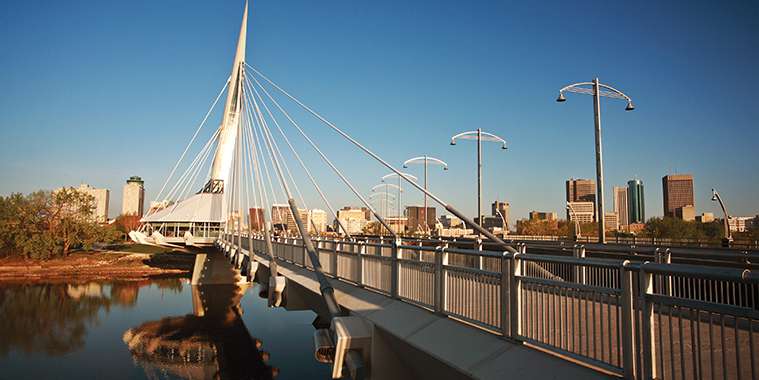The Capital Planning Region, operating as the Winnipeg Metropolitan Region (WMR), is required to adopt a regional plan by January 1, 2025, as mandated by the Province of Manitoba’s Capital Planning Region Regulation. In early November, the Winnipeg Metropolitan Region held several Plan20-50 public open houses to collect feedback on the draft regional plan, which then will be prepared for a first reading by the WMR Board.
Draft Plan20-50 is a 30-year framework to plan regional growth, infrastructure and servicing within the WMR, which consists of 18 municipalities including Cartier, East St. Paul, Headingley, Macdonald, Ritchot, Rockwood, Rosser, Springfield, St. Andrews, St. Clements, St. François Xavier, Taché, West St. Paul, the Village of Dunnottar, Town of Niverville, Town of Stonewall, City of Selkirk, and the City of Winnipeg. According to population figures from the 2021 Census, this region is home to 874,290 of Manitoba’s total population of 1,342,153 people, meaning nearly two-thirds of Manitoba calls the Winnipeg Metro Region home. With 2050 on the horizon, the WMR is projected to change substantially due to community life cycles, changing family sizes and an aging population.
With forecasted population growth within the WMR projected to reach 1.1 million people with approximately 510,000 jobs by 2050, regional planning is a tool to align growth, infrastructure and servicing agreements while coordinating common parameters to support land use and infrastructure planning. It can also ensure resources, natural assets, transportation corridors and economic activities vital to regional success are protected. This coordination can help further attract global investment and increase economic competitiveness for the entire region. When competing with other areas in Canada, the competition isn’t just with cities alone anymore, as multiple western metropolitan regions are already in operation in Vancouver, Victoria, Calgary, and Edmonton.
As part of the regional plan planning process, the WMR applied four policy lenses to develop policy that focus on what our future climate will be, protecting land, water and natural resources, reconciliation, and preparing for technological advances:
1. Build and Plan for Climate Resilience Action is required to mitigate the impacts of climate change in order to preserve growth and prosperity.
Key Considerations: Flood and drought resiliency; Greenhouse gas emissions reduction; Food security; Emergency preparedness; Safe, inclusive, and walkable communities; Transportation shift.
2. Protect, Restore, and Enhance Water, Land and Natural Resources Water, Land and Natural Resources are vital parts of what make our province unique, and these need to be protected in order to maintain the environment, our economy and what contributes to what it means to be Manitoban.
Key considerations: Watershed planning; Stewardship of land, water and other natural resources; Natural Asset Network; Protection of ecological health.
3. Reconciliation Regional success can only be achieved by establishing and maintaining relationships that truly collaborate with Indigenous Nations on shared priorities. This is a principle that leaders of the WMR are committed to.
Key considerations: Collaborative governance; Treaty land Entitlements, Land claims agreements,
Additions of reserve; Service sharing agreements; Indigenous knowledge.
4. Economic and Technological Transformation In order to attract new investment and increase our global competitiveness, economic and technological transformations may be necessary to fuel future growth. Investments need to be made, which can revolutionize industries and sectors, create new ones and bring global investors to the WMR to capitalize on our unique advantages.
Key considerations: Circular economy; Economic diversification; Business retention and expansion;
Job creation and retention; Regional benefit sharing; Regional data consistency and sharing.
There are five main policy areas in Draft Plan20-50; these policy areas being one of the subjects where feedback was being sought at the public open houses by asking participants for their top action priorities within these policy areas:
Policy Area 1: Integrated Communities and Infrastructure focuses on building strong, prosperous and sustainable communities by aligning growth with infrastructure and services. This supports the concept of complete communities with a range of housing, employment, services and amenities, including access to broadband. Transit-oriented development and active transportation features are also a vital part of this policy area.
Policy Area 2: Investment and Employment is a long-term goal associated with supporting growth, economic transformation and a global economically competitive region. Long-term regional economic prosperity can be supported by attracting investment, fostering business retention and expansion, and balancing job opportunities across the region. Prosperity is also supported by prioritizing the protection and development of transportation components like roads, railways, rail yards, rapid transit and airports. This approach prioritizes the intersection of jobs and residential areas as part of the development of complete communities to maximize the benefits of infrastructure investments.
Policy Area 3: One Environment is an acknowledgement that sustainability and climate resiliency are crucial features to possess in order to mitigate future challenges and continue to prosper. The Winnipeg Metropolitan Region is home to a variety of wetlands, grasslands and forests, which have many benefits regional planning needs to take into account, such
as the need for healthy water quality, biodiversity and wildlife habitat, and climate resilience. This means an emphasis on watershed management, balancing conservation and development while acknowledging the need for outdoor recreation and green infrastructure.
Policy Area 4: Resource Management on a regional scale has benefits for communities, our environment and our economy. The rich agricultural and mineral resources in our region are important economic assets that need to be managed sustainably over the long term. Resource lands are recognized in land use planning while measures are put in place to
protect against incompatible land use while supporting resource-based economies.
Policy Area 5: Collaborative Governance is an approach to governance that reinforces collaboration across the Winnipeg Metropolitan Region. In a region with many different jurisdictions, roles and responsibilities, a collaborative approach makes knowledge, skills and expertise sharing a priority while furthering opportunities for reconciliation between municipalities and Indigenous Nations.
At its core, Plan20-50 is about planning for the future in a collaborative way that prioritizes our unique provincial and regional advantages while strategizing what investments to make, when, where, and how to maximize the potential in the Winnipeg Metropolitan Region.
Visit 20to50.ca to learn more about Plan20-50 and its potential to shape our shared future.
Jeremy Davis is the Winnipeg Regional Real Estate Board’s Director External Relations & Market Intelligence.



